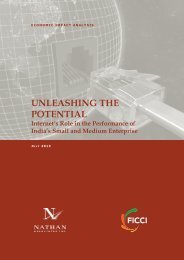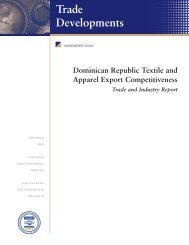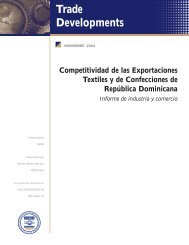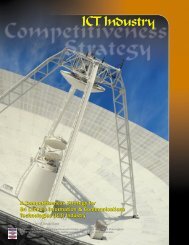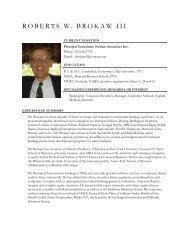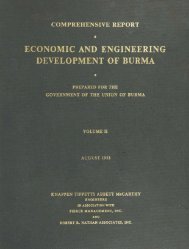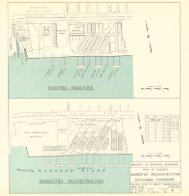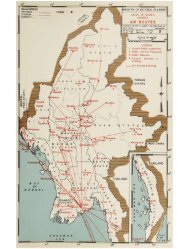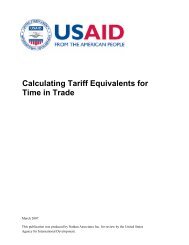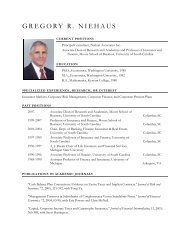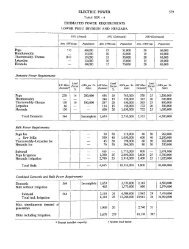Putting it to Work in Developing Countries - Nathan Associates
Putting it to Work in Developing Countries - Nathan Associates
Putting it to Work in Developing Countries - Nathan Associates
You also want an ePaper? Increase the reach of your titles
YUMPU automatically turns print PDFs into web optimized ePapers that Google loves.
complicated sequence of approvals and perm<strong>it</strong>s<br />
<strong>to</strong> establish foreign affiliates, develop land and<br />
s<strong>it</strong>es, connect <strong>to</strong> util<strong>it</strong>ies, and obta<strong>in</strong> and renew<br />
operat<strong>in</strong>g certificates (e.g., import-export perm<strong>it</strong>s,<br />
health and safety <strong>in</strong>spection, labor <strong>in</strong>spections).<br />
Costs and delays tend <strong>to</strong> be especially<br />
excessive for FDI-related land and s<strong>it</strong>e development<br />
perm<strong>it</strong>s, and for import-export operat<strong>in</strong>g<br />
requirements.<br />
To reduce the red tape that gives rise <strong>to</strong> these<br />
costs, reforms have concentrated on adm<strong>in</strong>istrative,<br />
technological, and <strong>in</strong>st<strong>it</strong>utional solutions:<br />
simplified paperwork, e-registrations and virtual<br />
<strong>in</strong>teragency networks, and one-s<strong>to</strong>p shops.<br />
Though useful, these solutions are not necessarily<br />
au<strong>to</strong>matic or complete. For example, the success<br />
of one-s<strong>to</strong>p shops is a function of clearly<br />
def<strong>in</strong><strong>in</strong>g mandates and l<strong>in</strong>es of author<strong>it</strong>y <strong>to</strong><br />
FDI and EPZs Spur Economic Development <strong>in</strong> Maur<strong>it</strong>ius<br />
cr<strong>it</strong>ical <strong>to</strong> <strong>in</strong>dustrial diversification, employ-<br />
ment, export development, and economic<br />
growth. Indeed, Maur<strong>it</strong>ius demonstrates<br />
how <strong>in</strong>ward FDI can stimulate domestic<br />
<strong>in</strong>vestment and outward FDI—the country’s<br />
ma<strong>in</strong> exporters are now national com<br />
panies.<br />
In the 1990s, manufactur<strong>in</strong>g FDI decl<strong>in</strong>ed<br />
as labor productiv<strong>it</strong>y stagnated, labor costs<br />
rose, preferential trade access ended, and<br />
cheaper regional alternatives emerged. The<br />
chang<strong>in</strong>g dynamics of the garment/textile<br />
sec<strong>to</strong>r prompted South-South <strong>in</strong>vestment<br />
outflows (e.g., <strong>to</strong> Madagascar) and an<br />
expansion of <strong>in</strong>vestment <strong>in</strong> the services sec<br />
<strong>to</strong>r. In the late 1990s, offshore services<br />
began <strong>to</strong> provide high value-added jobs for<br />
bankers, lawyers, accountants, and others.<br />
As of December 2001, some 14,000 offshore<br />
ent<strong>it</strong>ies were registered w<strong>it</strong>h the<br />
Maur<strong>it</strong>ian government, many target<strong>in</strong>g<br />
commerce <strong>in</strong> India and South Africa. The<br />
government is now us<strong>in</strong>g <strong>in</strong>vestment <strong>in</strong>cen<br />
tives <strong>to</strong> promote the services sec<strong>to</strong>r. Its<br />
“Cyber C<strong>it</strong>y Project,” for example, is<br />
designed <strong>to</strong> attract call centers (especially<br />
serv<strong>in</strong>g Francophone Africa, France, and<br />
Canada); companies <strong>in</strong>vest<strong>in</strong>g <strong>in</strong> call centers<br />
and back office services can opt for a uniform<br />
corporate tax rate of 5 percent.<br />
Its development prospects famously<br />
declared grim by economist and Nobel Prize<br />
w<strong>in</strong>ner James Meade <strong>in</strong> the early 1960s,<br />
Maur<strong>it</strong>ius has confounded expectations <strong>to</strong><br />
become a rare success <strong>in</strong> sub-Saharan Africa.<br />
Maur<strong>it</strong>ius’ transformation from a monocrop<br />
sugar economy <strong>to</strong> a diversified one—<br />
services now make up 70 percent of<br />
GDP—reflects a development path cat-<br />
alyzed by FDI.<br />
In 1970, the country was the first <strong>in</strong> Africa<br />
<strong>to</strong> adopt an Export Process<strong>in</strong>g Zone (EPZ)<br />
act. On the basis of <strong>it</strong>s access <strong>to</strong> markets<br />
under the Lome Convention, peaceful multicultural<br />
social relations, very high rate of<br />
multil<strong>in</strong>gual l<strong>it</strong>eracy, and <strong>in</strong>centives such as<br />
tax holidays, Maur<strong>it</strong>ius conv<strong>in</strong>ced Ch<strong>in</strong>ese<br />
and other Asian <strong>in</strong>ves<strong>to</strong>rs <strong>to</strong> locate textile<br />
and garment production <strong>in</strong> <strong>it</strong>s EPZs. The<br />
country’s EPZ strategy <strong>to</strong>ok root and flour-<br />
ished <strong>in</strong> the 1970s and aga<strong>in</strong> <strong>in</strong> the 1980s, a<br />
boom time for mult<strong>in</strong>ationals mov<strong>in</strong>g <strong>in</strong><strong>to</strong><br />
the zones <strong>to</strong> take advantage of generous<br />
<strong>in</strong>centives offered by the government (e.g.,<br />
reduced corporate tax rates). Instrumental<br />
<strong>in</strong> consolidat<strong>in</strong>g support for the EPZ and<br />
shap<strong>in</strong>g related policy was the Maur<strong>it</strong>ius<br />
Export Development and Investment<br />
Author<strong>it</strong>y (MEDIA), now known as the<br />
Maur<strong>it</strong>ius Industrial Development<br />
Author<strong>it</strong>y (MIDA). FDI <strong>in</strong> the EPZ proved<br />
63



